It sounds like a piece of equipment for rendering birds blind but relax, that is not what a bird blind is. In this article, you will discover all you need to know about bird blinds from a keen bird watcher and bird photographer.
A bird blind or bird hide is a structure or piece of equipment used to conceal a person while they watch or photograph birds. It’s easier to observe natural bird behavior by using a bird blind. There are many different types of bird blinds, including permanent structures and portable one-person tents.
In the remainder of this article, I’m going to dive into bird blinds in more detail. You will learn more about the types of blinds, why you might want to use one, and so much more.

As an Amazon Associate, I earn from qualifying purchases. Birdwatch World earns commissions from Amazon and similar affiliate programs from any purchases made via links in this article.
What Is A Bird Blind?
A bird blind (also called a bird hide) is a structure used by bird watchers or bird photographers. They are called bird blinds because they essentially make the birds blind to your presence. As you can see in the image below, these structures will usually have small viewing windows through which people can watch birds but not be seen.

Bird blinds can be made from any type of timber, metal, or any other material. They can be a hut like the one in the image above, a tower, or just a wall with tiny windows as in the picture below:
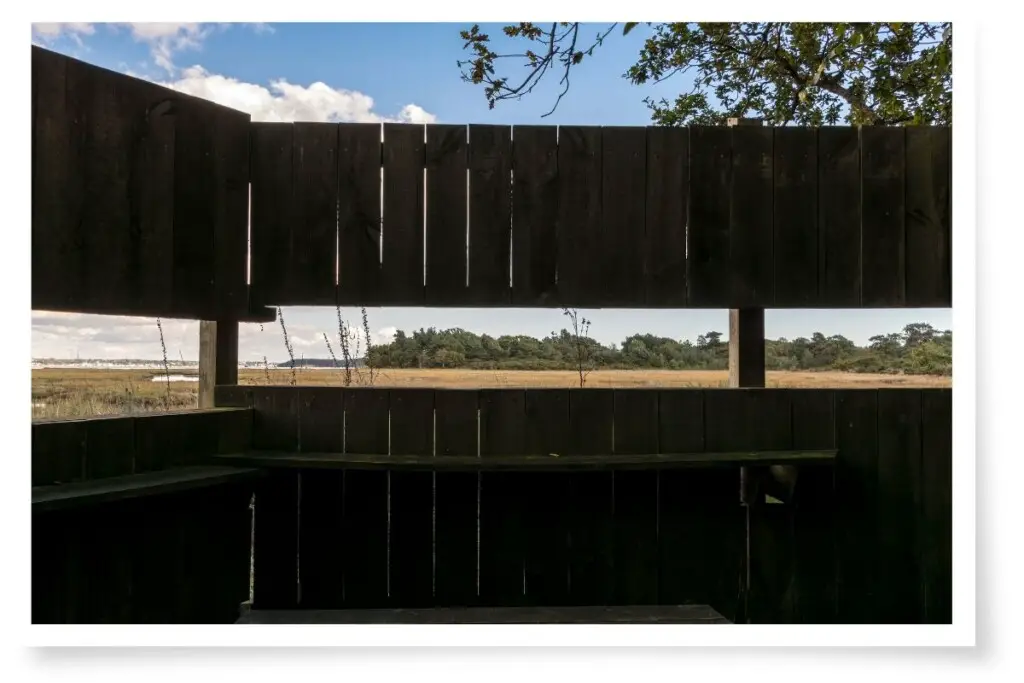
Some bird blinds are built using vertical timber slats such as this one:

Let’s take a look at the different types of bird blinds/hides…
Are bird watchers weird? Find out in this article here on my site.
Different Types Of Bird Blinds
Bird blinds come in many different shapes and sizes. The most common type of blind is a hut, more commonly called a bird hide.
Bird Hide Hut
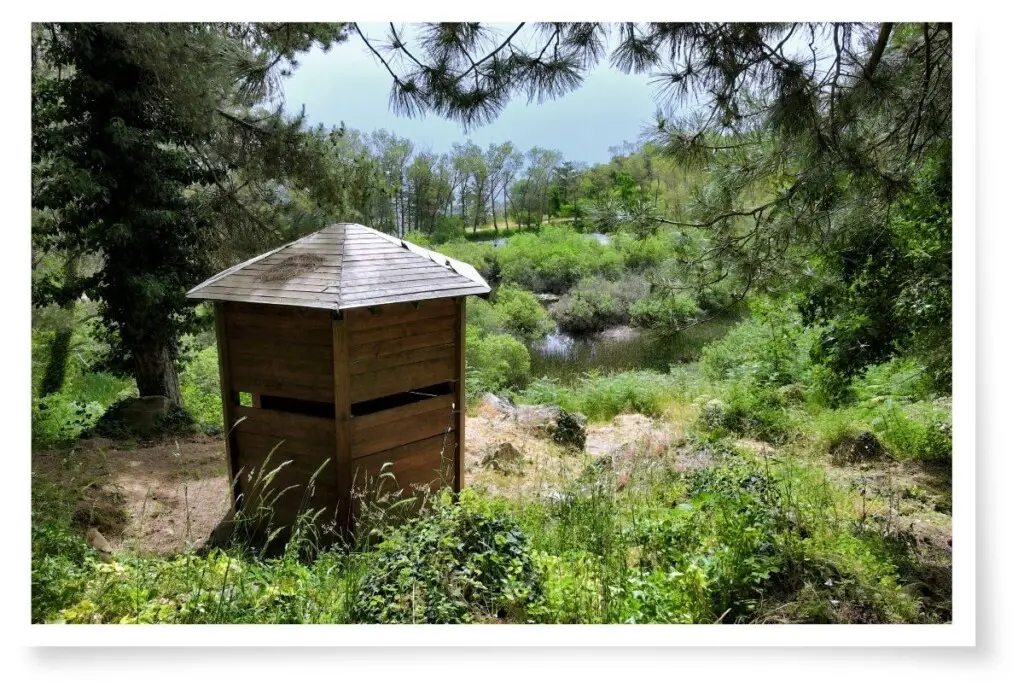
These types of hides can be a small hut on the ground or raised slightly on posts or pylons. They will generally have slit windows but some have larger openings.
Inside, depending on the size of the hut, there might be wooden seats to sit on while you are birdwatching and shelves to rest your binoculars on. There may even be some form of stationary binoculars for anyone to use.
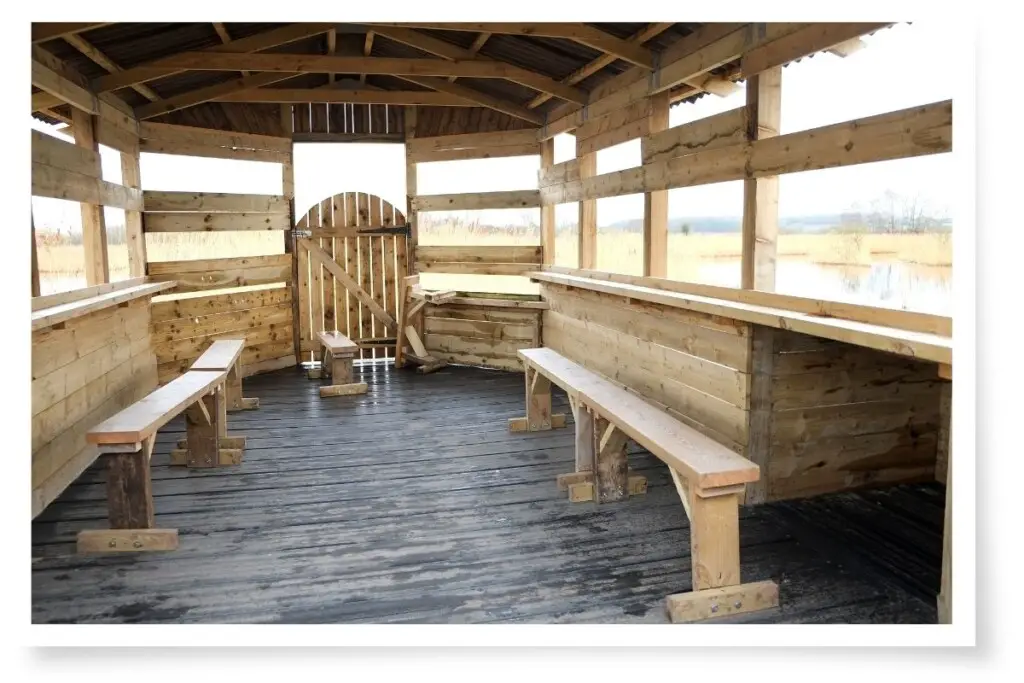
Bird Blind Tower
These are similar to a hut only they are raised very high to give people a better view of a birding area.

These types of tower hides are often found in wetlands where it’s necessary to see a wider expanse of the landscape. You may also find these in forests or woodlands where they will be raised above the tree canopy.
Discover what other things bird watchers need in this article.
Bird Blind Wall
Bird blind walls (more often called bird blinds) are simply walls with long thin windows to look through. They are essentially bird-hide huts without other walls. Sometimes they will have roofs and other times they will not.
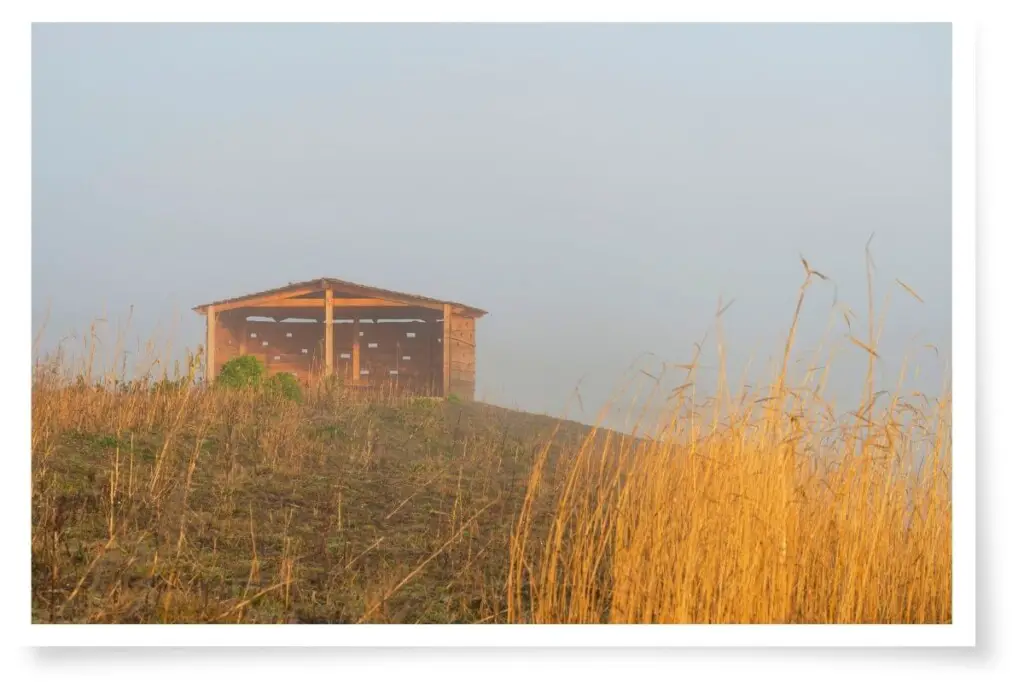
This type of hide will be built on the edge of a lake, grassland, or another birdwatching area where the habitat is more in front of it than behind it.
Portable Bird Blinds/Hides
These are the go-anywhere hide that you can take with you and set up in any place you like. A portable bird blind can be a small tent, a collapsable wall, a covered camouflage chair (top right below), a camouflage net (middle bottom), a coat or bag (bottom right), or even a camouflage suit (left) that the bird watcher or bird photographer will wear.
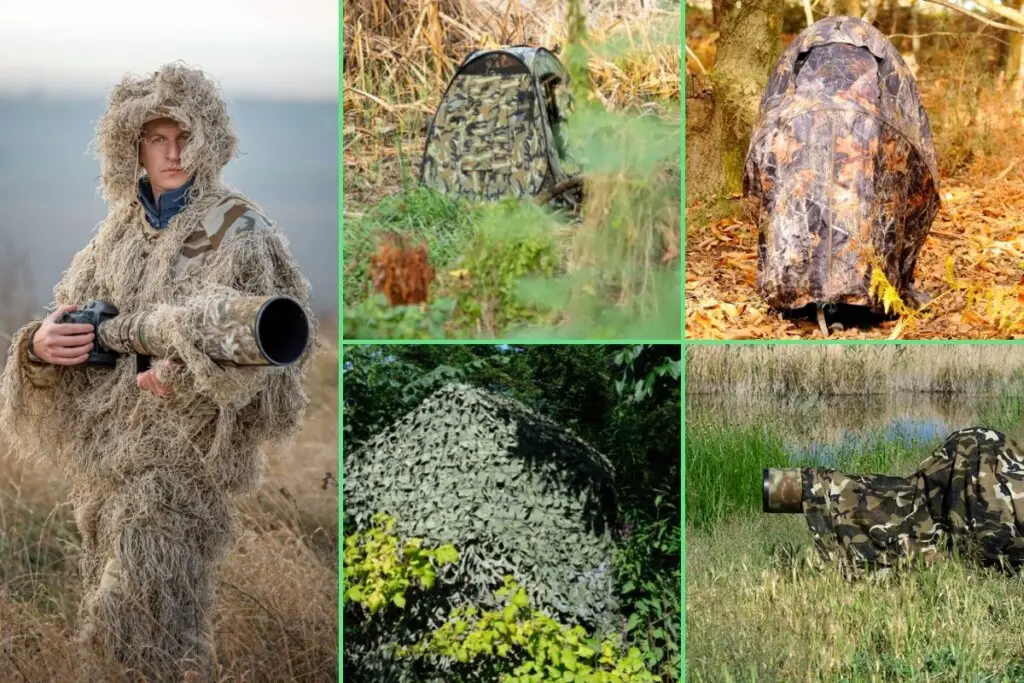
The best type of portable bird hide is your car. If you can position your vehicle in a perfect spot where you can watch or photograph birds, you can sit there in comfort and enjoy the wildlife.
Discover 10 proven ways to find birds to watch or photograph in this article here on my blog.
The Floating Bird Blind
Another type of bird blind that is only for the adventurous birder or photographer is the floating hide.

These can be homemade constructions such as the one above which appears to be made from a tent hide and an inflatable raft, or commercially made such as those from Floating Hide.
While you do have to be a little brave to use one of these, they can afford you some amazing views of waterbirds and some incredible photos too.
Why use a bird blind though? What exactly does it do? Let’s find out…
Why Use A Bird Blind?
Birds, especially the smaller ones, are always on alert. They constantly scan their surroundings for any movement or sounds that may indicate a predator is near. Through their eyes, we are predators and they will instantly change their behavior whenever we are around.
The purpose of a bird blind is to hide us from them so they don’t notice our presence and behave in their natural way. Though hidden from the birds in a blind, it is still important for a bird watcher to remain still and quiet so as not to startle the birds.
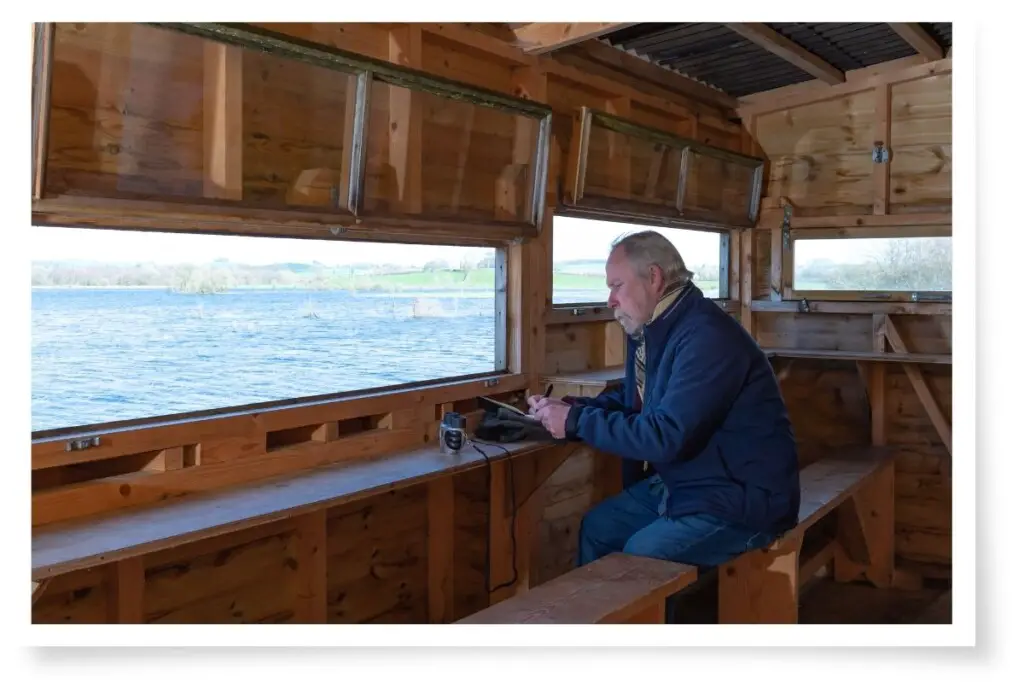
Any kind of permanent structure such as a bird hide hut or tower is something the birds will see every day. They know it’s not a danger to them and as such, a bird watcher can sit in there for hours enjoying their behavior without scaring them.
In the case of the portable camouflaged hides, they blend into the surroundings and help to make a person less conspicuous to birds. It is still important to remain still and quiet when using a portable bird blind.
When To Use A Bird Blind
Do you have to use a bird blind whenever you are bird watching? No, of course, you don’t. You can stand or sit very still out in the open and birds will sometimes approach very close to you.
As I outlined in the previous section though, if birds know you’re there, they will change their behavior so without a blind, you may not get to see their natural behavior.
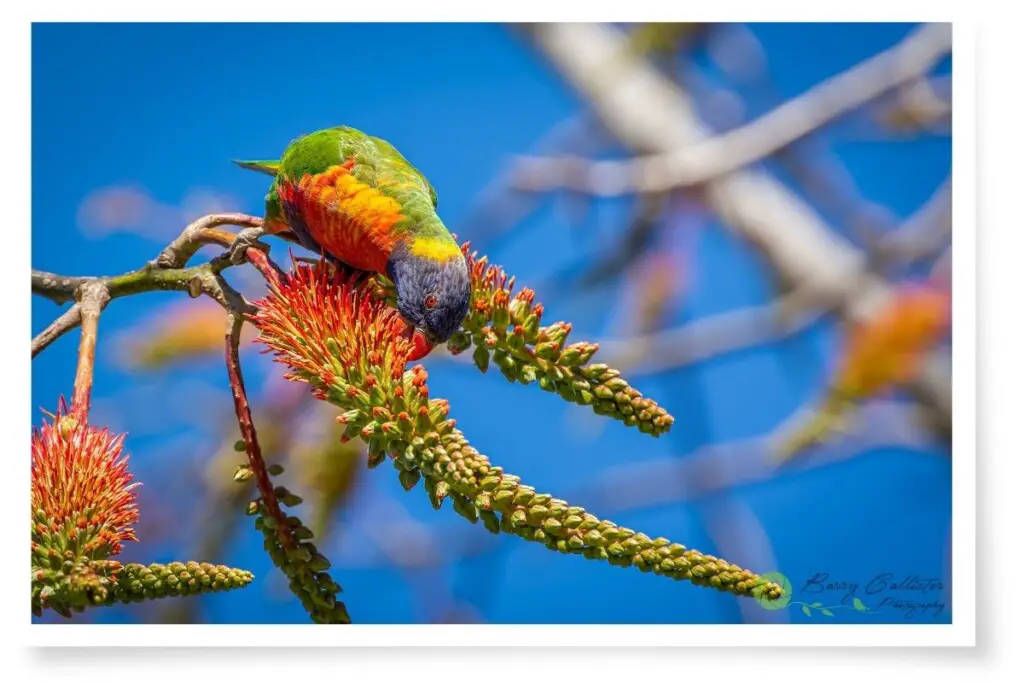
Avid bird watchers may choose to use a hide most times they go out birding if one is available. Portable hides are used more often by bird photographers than bird watchers but I’m sure some die-hard bird watchers use them.
There are some bird species that you just will not be able to get close to so a good pair of binoculars and a bird blind will be essential.
Where You Might Find Bird Blinds
If you are lucky, you might have a park or lake nearby that has a bird blind in it. A lot of public nature spots have bird blinds, even in suburban and urban areas.

Other places you may find bird blinds are:
- National Parks
- Botanic Gardens
- Bird Sanctuaries
- Nature Reserves
- Lakes
- Wetlands
- Swamps
- Coastal Areas
To find hides in your area, simply Google “bird hides near me” and you will hopefully find results in your area.
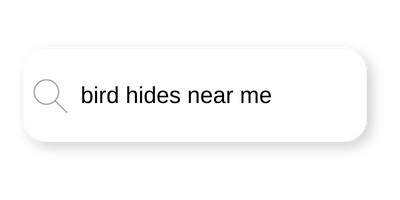
If you are thinking of getting your own portable hide, you will find loads of options on Amazon. You can always have a go at making your own, there are some great ideas in this blog post from Robert E. Fuller.
Conclusion
Now you know what a bird blind is, why you would want to use one, and a whole lot more about the different types of blinds/hides.
Remember if you are out in nature, always be respectful to the birds and other wildlife and try to leave them alone.

Please do not bait birds to get them to your hide, it can lead to all kinds of problems such as changes in their feeding behaviors, overcrowding in populations, and diseases. Read more about this in my Can Birds Eat Bread? – No and don’t feed it to them article.
Thanks for taking the time to read this post today. Happy birding, I’ll see you out there perhaps?
